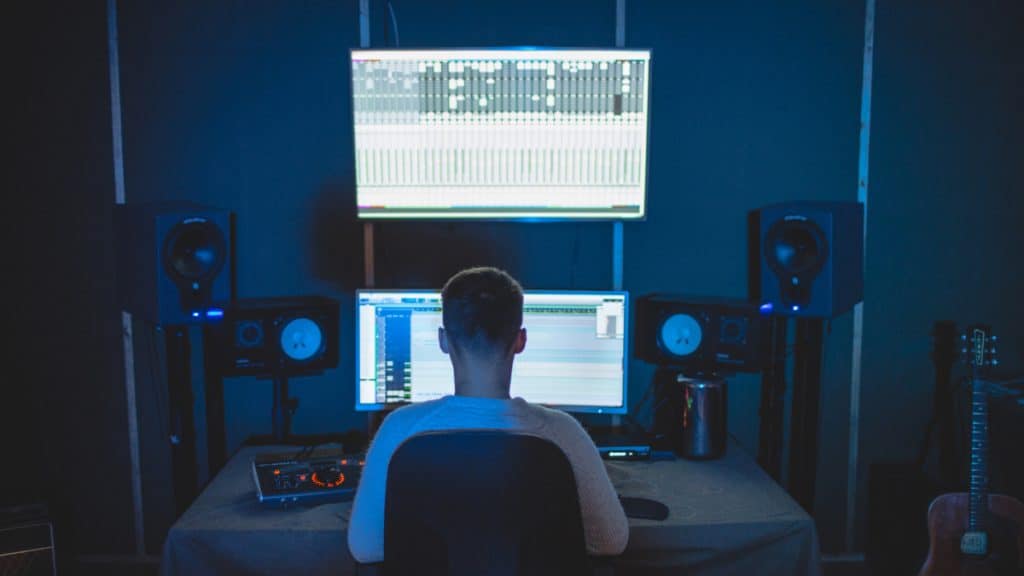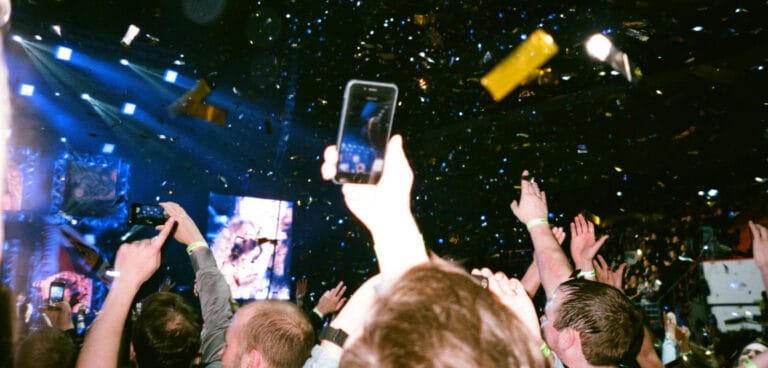Promote your electronic music or an EDM release requires a strategic approach that combines various marketing techniques.
Here are ten steps to effectively promote your music:
Step 1: Create Quality Music

The first step in promoting your music is to create quality tracks. This involves focusing on sound design, perfecting the mix, and mastering the final product. Your music is the product you’re selling and needs to be good to stand out in a crowded market.
Creating quality music starts with the composition process. This is where you make the melody, rhythm, and structure of your track. It’s essential to experiment with different sounds and styles to create a unique and exciting track.
Next, you need to focus on the production process. This involves recording, editing, and mixing your track to create a polished final product. You need to pay attention to details like the balance of different elements in the mix, the clarity of the sound, and the overall dynamics of the track.
At last, you need to master your track. Mastering is the final step in the production process, where you fine-tune the sound of your track to make it sound professional and ready for release. It involves adjusting the overall volume, EQ, and track dynamics.
Step 2: Define Your Brand
Your brand is what sets you apart from other artists. It includes your music, image, personality, and values.
To define your brand, you must know who you are as an artist. What is your musical style? Which are your values? What is your story? These elements are what make you unique.
Your brand reflects who you are as an artist and resonates with your target audience. This will help you create a strong connection with your fans.
Also, you need a visual identity. This includes your logo, album artwork, and promotional photos. Your visual identity should be consistent across all your marketing materials to create a cohesive brand image.
Finally, communicate your brand to your audience. This involves creating a compelling artist bio and crafting your social media posts.
Step 3: Build a Strong Online Presence
A solid online presence is crucial for music promotion in today’s digital age. This includes building a professional website, creating profiles on social media platforms like Facebook, Instagram, and Twitter, and signing up for artist services offered by music streaming platforms.
Building a solid online presence starts with a professional website. Your website is your home, where fans can learn more about you, listen to your music, and find out about upcoming shows. Keep your website up-to-date and easy to navigate.
Remember social media. You need to create social media accounts. Social Channels allow you to connect with your fans and promote your music. You should post regularly, interact with your fans, and use these platforms to showcase your brand.
Music promotion services offered by streaming platforms can help you get your music in front of a larger audience, track your streaming analytics, and make money from your music.
Note: Regularly update your online platforms with engaging content to keep your fans interested and attract new ones.
Step 4: Develop a Social Media Strategy
To promote your music, you need 360º Music Marketing.
Develop a social media strategy that includes regularly posting engaging content, interacting with your fans, and using paid advertising to reach a wider audience.
Your strategy starts with choosing the right platforms. It would help to focus on the media where your target audience spends the most time. For example, if your target audience is young adults, you might focus on Instagram and TikTok.
For social platforms and blogs, you need to create engaging content. This could include behind-the-scenes photos, videos of you working in the studio, or clips of your latest tracks. You should aim to post regularly to keep your fans engaged and interested.
@fredagainagain pre show at Hollywood Forever on the Maschine 🎉🥳 #newmusic #electronicmusic
♬ original sound – Fredagainagain
A crucial part of your social media strategy is to interact with your fans, this could involve responding to comments, hosting Q&A sessions, or sharing fan-created content. Engaging with your fans can help you build a strong community around your music.
If you want to speed up your growth, you should consider using paid advertising to reach a wider audience. You can target your ads based on demographics, interests, and behaviors to reach potential fans who are likely to enjoy your music.
Step 5: Build a Loyal Fanbase
Building a loyal fanbase is crucial for a successful music career. Engage with your fans through social media, live performances, and email marketing. Offer exclusive content, discounts, or early access to your music to fans who join your email list. The more you engage with your fans, the more likely they will support you.
Building a loyal fanbase starts with understanding who your fans are. You should aim to understand their demographics, interests, and behaviors. This can help you create content that resonates and builds a strong connection with them.
Next, you need to engage with your fans. This could involve responding to comments on social media, hosting live performances, or sending regular updates via email. The more you engage with your fans, the more likely they will stay loyal to you.
Finally, you should offer exclusive content or perks to your fans. This could involve early access to new tracks, discounts on merchandise, or exclusive behind-the-scenes content. Offering exclusive bonuses can help you build a strong relationship with your fans and encourage them to support you.
Step 6: Use Email Marketing
Email marketing is a powerful tool for building a loyal fanbase. It lets you directly communicate with your fans and update them on your latest releases, upcoming shows, and exclusive content. Use an email marketing service to collect email addresses from your fans, send out regular newsletters, and track your email marketing performance.
Using email marketing starts with building an email list. You can do this by offering a free download of one of your tracks in exchange for an email address or asking fans to sign up for your newsletter at your shows.
Next, you need to create the engaging email content. It could involve updates on your latest releases or exclusive offers. You should aim to send regular emails to keep your fans engaged and interested.
Finally, you should track your email marketing performance. It involves looking at metrics like open, click-through, and conversion rates. Tracking your performance can help you understand what’s working and what’s not and adjust your strategy accordingly.
Step 7: Network with Industry Professionals

Networking with industry professionals like singers, bloggers, and other musicians can provide invaluable exposure for your music. Building relationships with these professionals can lead to opportunities like getting your music played on the radio, being invited to festivals, appearing on popular music blogs, or collaborating with other musicians.
Networking is based on identifying the industry professionals who can help you reach your goals. This could be researching local producers involved in your music genre, reaching out to music bloggers or magazines covering your genre, or connecting with other musicians with a similar style.
You need to build relationships with these professionals. This could involve attending industry events, sending personalized emails, or offering to collaborate on a project.
Networking is about building genuine relationships, not just asking for favors.
It would help if you leveraged your network to promote your music. This could involve asking to be included in an event, getting a blogger to review your album, or collaborating with another musician on a track.
Step 8: Get Your Music on Playlists
Getting your music on popular playlists on streaming platforms like Spotify and Apple Music can significantly increase your streams and exposure. Submit your music to playlist curators or use playlist pitching services to increase your chances of getting featured.
Getting your music on playlists starts with identifying the right playlists for your music. You should look for playlists that feature your genre of music and have a large number of followers.
Next, you need to submit your music to playlist curators. This involves sending a professional and personalized pitch that explains why your track would be a good fit for their playlist.
Also, you can consider using a playlist pitching service. These services can simultaneously submit your music to multiple playlists, increasing your chances of getting featured.
Step 9: Run Contests or Giveaways
Running contests or giveaways can generate buzz around your music and engage your fans. Offer prizes like concert tickets, merchandise, or VIP passes. Promote your contests or giveaways on social media, email marketing, or website.
First, choose an attractive prize that your fans will be excited about. This could be a signed album, a pair of tickets to your next show, or a chance to meet you in person.
You need to promote your contest or giveaway. You should create engaging promotional content and share it on your social media platforms, email newsletters, and website.
Finally, you should engage with your fans during the contest or giveaway. This could involve responding to comments, sharing updates on the contest, or announcing the winner in a live video.
Step 10: Monitor Your Progress and Adjust Your Strategy
Track your progress towards your music promotion goals using analytics tools on social media and streaming platforms. Monitor what’s working and not, and adjust your strategy as needed. Remember, successful music promotion requires consistency and adaptability.

Monitoring your progress needs clear and measurable goals for your music promotion. This could involve increasing your number of Spotify streams, growing your social media following, or selling out your next show.
On the base of these goals, you can track your actual progress. You can use analytics tools on social media and streaming platforms to see how your music performs.
You should adjust your strategy according to your results. Feel free to try a new approach if something needs to be fixed. Remember, the key to successful music promotion is adaptability and willingness to learn from mistakes.
In conclusion, promoting electronic music requires a comprehensive approach that combines various marketing techniques.
By following these ten steps, you can effectively promote your music, build a loyal fanbase, and succeed in the electronic music industry. Remember, the key to successful music promotion is consistency. Keep creating, keep promoting, and keep engaging with your fans. Your hard work will pay off in the end.




